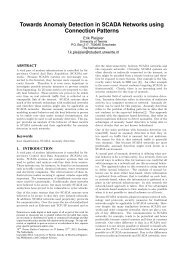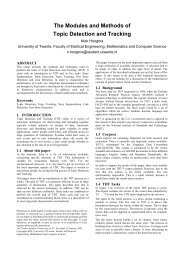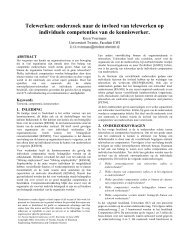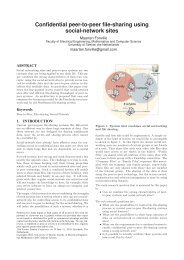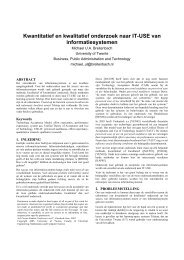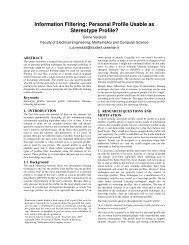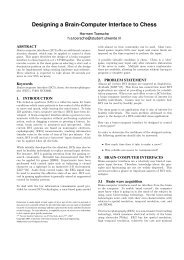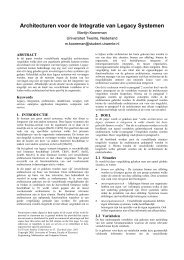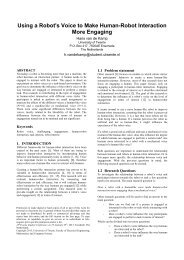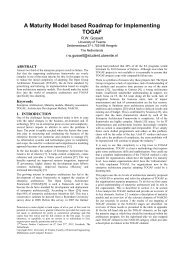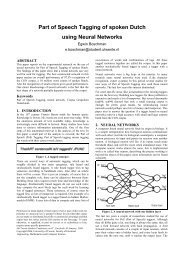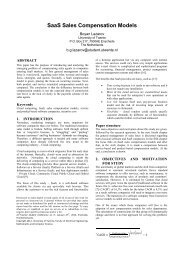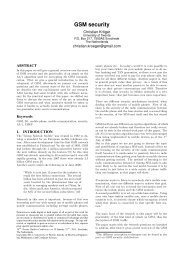Proceedings Template - WORD - Twente Student Conference on IT
Proceedings Template - WORD - Twente Student Conference on IT
Proceedings Template - WORD - Twente Student Conference on IT
You also want an ePaper? Increase the reach of your titles
YUMPU automatically turns print PDFs into web optimized ePapers that Google loves.
4. What is the effect of the IEEE 1609.4 channel<br />
switching procedure <strong>on</strong> the c<strong>on</strong>clusi<strong>on</strong>s of the<br />
existing IEEE 802.11p simulati<strong>on</strong> experiments<br />
5. Which soluti<strong>on</strong>s can be used to minimize the impact<br />
of the IEEE 1609.4 channel switching procedure <strong>on</strong><br />
the IEEE 802.11p performance<br />
This research will be a combinati<strong>on</strong> of literature study and<br />
simulati<strong>on</strong> experimentati<strong>on</strong>. The research questi<strong>on</strong>s (1), (2) and<br />
(3) will be answered based <strong>on</strong> literature study. The answers to<br />
these three research questi<strong>on</strong>s will provide the informati<strong>on</strong> to be<br />
used <strong>on</strong> answering research questi<strong>on</strong> (4). In particular, the<br />
fourth research questi<strong>on</strong> will be answered by performing and<br />
analysing simulati<strong>on</strong> experiments, using the OMNeT++<br />
simulati<strong>on</strong> tool [16]. Existing IEEE 802.11p models will be<br />
modified to implement the 1609.4 channel switching<br />
procedures. The results of these experiments will be compared<br />
and analysed. The answer to research questi<strong>on</strong> (5) is based <strong>on</strong><br />
literature study used to find soluti<strong>on</strong>s that minimize the impact<br />
of the IEEE 1609.4 channel switching procedure <strong>on</strong> the IEEE<br />
802.11p beac<strong>on</strong>ing performance.<br />
This paper is organized as follows. Secti<strong>on</strong> 2 provides an<br />
overview of the specificati<strong>on</strong>s of IEEE 802.11p and IEEE<br />
1609.4. Moreover, Secti<strong>on</strong> 2 answers research questi<strong>on</strong>s (1) and<br />
(2). In Secti<strong>on</strong> 3 an overview of the simulati<strong>on</strong> experiments is<br />
given in which the impact of the channel switching procedures,<br />
defined in IEEE 1609.4 are evaluated. Furthermore, Secti<strong>on</strong> 3<br />
provides the answers to research questi<strong>on</strong>s (3) and (4). Secti<strong>on</strong><br />
4 provides an overview of the soluti<strong>on</strong>s that are designed to<br />
minimize the impact of the IEEE 1609.4 channel switching<br />
procedures <strong>on</strong> the IEEE 802.11p performance. Moreover,<br />
Secti<strong>on</strong> 4 provides the answers to research questi<strong>on</strong> (5). Secti<strong>on</strong><br />
5 c<strong>on</strong>cludes and provides recommendati<strong>on</strong>s for future work.<br />
Figure 1. By vehicle-to-vehicle and vehicle-to-roadside<br />
communicati<strong>on</strong>, accidents can be avoided, copied from [7]<br />
2. IEEE 802.11P BEACONING AND IEEE<br />
1609.4 CHANNEL SW<strong>IT</strong>CHING<br />
This secti<strong>on</strong> provides an overview of the specificati<strong>on</strong>s of IEEE<br />
802.11p and IEEE 1609.4.<br />
2.1 IEEE 802.11p beac<strong>on</strong>ing<br />
In 1999, the U.S. Federal Communicati<strong>on</strong> Commissi<strong>on</strong><br />
allocated 75MHz of Dedicated Short Range Communicati<strong>on</strong>s<br />
(DSRC) spectrum in the frequency band 5.85-5.925 GHz for<br />
vehicle-to-vehicle (V2V) and vehicle-to-infrastructure (V2I)<br />
communicati<strong>on</strong>s [12]. V2V refers to the direct communicati<strong>on</strong><br />
between vehicles, while V2I refers to the communicati<strong>on</strong><br />
between vehicles and the infrastructure network. This 75MHz<br />
band is divided in seven 10 MHz-wide channels. One channel is<br />
the c<strong>on</strong>trol channel (CCH) and the remaining six channels are<br />
the service channels (SCHs), as seen in Figure 2. In Europe a 50<br />
MHz wide spectrum has been allocated for VANETs by the<br />
European Telecommunicati<strong>on</strong>s Standards Institute (ETSI) [3].<br />
Figure 2. Channels in IEEE 802.11p, copied from [12]<br />
The IEEE 802.11p protocol is an amendment of the IEEE<br />
802.11 specificati<strong>on</strong>, which was standardized in 2010 [11].<br />
IEEE 802.11 establishes and maintains the communicati<strong>on</strong>s in a<br />
Basic Service Set (BSS). IEEE 802.11p has been developed to<br />
simplify the BSS operati<strong>on</strong>s in an ad hoc manner for vehicular<br />
usage. The overhead of IEEE 802.11 c<strong>on</strong>necti<strong>on</strong> setup, like<br />
multiple handshake, is too expensive to be used in VANETs.<br />
Therefore IEEE 802.11p introduces Wave BSS (WBSS). A<br />
node broadcasts <strong>on</strong>e message, a demand beac<strong>on</strong> [12]. This<br />
demand beac<strong>on</strong> c<strong>on</strong>tains all informati<strong>on</strong> needed by receiving<br />
nodes to understand what services this node supports and how<br />
to c<strong>on</strong>figure itself to join the WBSS, such that other nodes can<br />
join the WBSS without further acti<strong>on</strong>s.<br />
Within a WBSS nodes exchange beac<strong>on</strong>s to create a<br />
cooperative awareness. Beac<strong>on</strong>s are small messages, which<br />
c<strong>on</strong>tain a message as defined by the European <strong>IT</strong>S VANET<br />
Protocol (EIVP), with approximately 400 bytes of informati<strong>on</strong>,<br />
including security fields [15]. Beac<strong>on</strong>s can c<strong>on</strong>tain informati<strong>on</strong><br />
like locati<strong>on</strong>, speed, accelerati<strong>on</strong> and directi<strong>on</strong> of a node. They<br />
are sent <strong>on</strong> a regular interval, e.g. every 100 millisec<strong>on</strong>ds, to<br />
ensure that all the nodes have an up-to-date cooperative<br />
awareness.<br />
When all nodes are sending beac<strong>on</strong>s at the same time, the<br />
beac<strong>on</strong>s may collide. When the vehicle density is str<strong>on</strong>gly<br />
increasing, collisi<strong>on</strong>s between beac<strong>on</strong>s are to be expected. In<br />
this way fewer beac<strong>on</strong>s are received successfully and the<br />
cooperative awareness becomes less accurate. To prevent this<br />
IEEE 802.11p uses a Medium Access C<strong>on</strong>trol (MAC) protocol<br />
based <strong>on</strong> the Carrier Sense Multiple Access protocol with<br />
Collisi<strong>on</strong> Avoidance (CSMA/CA) [8]. This means that when a<br />
node wants to send a message, it first listens to the channel for a<br />
durati<strong>on</strong> of an Arbitrati<strong>on</strong> Inter-Frame Spacing (AIFS) period,<br />
see Figure 3. If the channel is idle it starts transmissi<strong>on</strong>. When it<br />
finds the channel busy, it chooses a random backoff time from<br />
the interval [0, CW] and transmits <strong>on</strong>ly when the backoff timer<br />
has elapsed. The variable CW represents the size of the<br />
C<strong>on</strong>tenti<strong>on</strong> Window. When the SCH is used and a node does<br />
not receive an acknowledgement for a message, it c<strong>on</strong>cludes<br />
that the message had collided and is lost, so the value of CW is<br />
doubled. In the CCH however beac<strong>on</strong>s are broadcasted in the<br />
channel and no acknowledgments are sent [6]. This means that<br />
the value of CW is never doubled in the CCH.<br />
Table 1: Parameters in EDCA, copied from [8]<br />
The IEEE 802.11p protocol specificati<strong>on</strong> also supports Quality<br />
of Service (QoS) differentiati<strong>on</strong> [11] by using the Enhanced<br />
Distributed Channel Access (EDCA) from the IEEE 802.11e<br />
standard, see e.g., [6]. EDCA can classify beac<strong>on</strong>s based <strong>on</strong><br />
four access categories (ACs); background traffic (BK), best<br />
effort traffic (BE), voice traffic (VO) and video traffic (VI).<br />
Differentiati<strong>on</strong> between the categories is accomplished by



